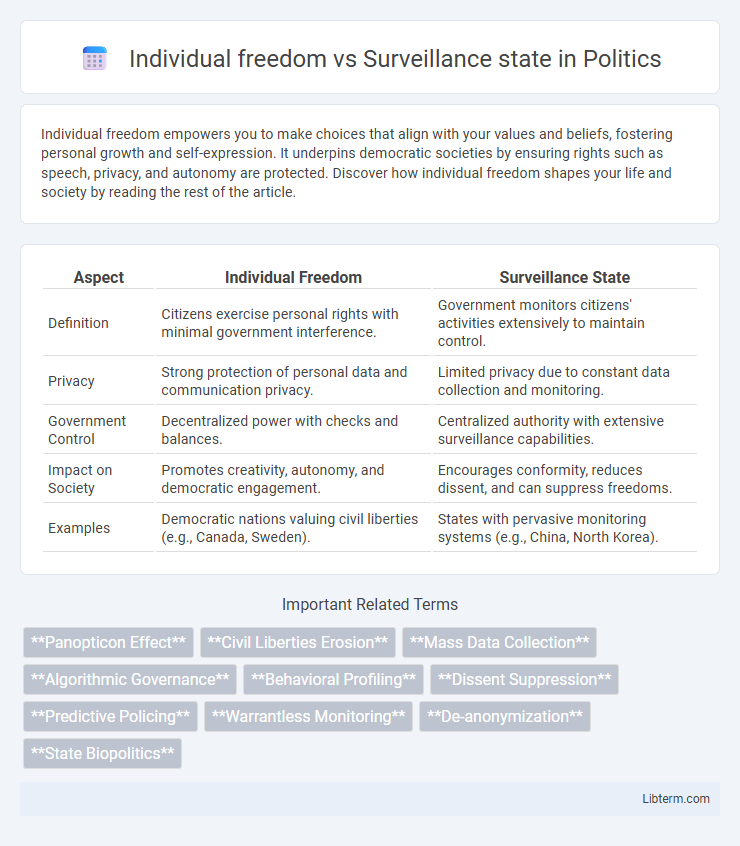Individual freedom empowers you to make choices that align with your values and beliefs, fostering personal growth and self-expression. It underpins democratic societies by ensuring rights such as speech, privacy, and autonomy are protected. Discover how individual freedom shapes your life and society by reading the rest of the article.
Table of Comparison
| Aspect | Individual Freedom | Surveillance State |
|---|---|---|
| Definition | Citizens exercise personal rights with minimal government interference. | Government monitors citizens' activities extensively to maintain control. |
| Privacy | Strong protection of personal data and communication privacy. | Limited privacy due to constant data collection and monitoring. |
| Government Control | Decentralized power with checks and balances. | Centralized authority with extensive surveillance capabilities. |
| Impact on Society | Promotes creativity, autonomy, and democratic engagement. | Encourages conformity, reduces dissent, and can suppress freedoms. |
| Examples | Democratic nations valuing civil liberties (e.g., Canada, Sweden). | States with pervasive monitoring systems (e.g., China, North Korea). |
The Evolution of Individual Freedom in Modern Society
The evolution of individual freedom in modern society reflects a dynamic tension between expanding personal liberties and the increasing capabilities of state surveillance technologies. Advances in digital communication and data collection have challenged traditional notions of privacy, necessitating new legal frameworks to safeguard individual rights. Despite growing surveillance infrastructures, movements advocating for encryption, data protection, and transparent governance continue to redefine the boundaries of freedom in the digital age.
Defining the Surveillance State: Tools and Techniques
The surveillance state employs advanced tools such as mass data collection, facial recognition technology, and pervasive electronic monitoring to track citizens' activities. Governments often use algorithms, metadata analysis, and AI-driven predictive policing to process vast amounts of personal information. These techniques enable comprehensive control and oversight, raising critical concerns about privacy and individual freedom.
Historical Context: Freedom vs State Control
Throughout history, the tension between individual freedom and state control has shaped governance and civil rights, with authoritarian regimes often prioritizing surveillance to maintain power. The rise of totalitarian states in the 20th century exemplified extreme state control, using widespread surveillance to suppress dissent and limit personal freedoms. Conversely, democratic societies have continually negotiated the balance between security measures and protecting individual liberties, emphasizing privacy rights and legal frameworks to curb government overreach.
Digital Privacy in the Age of Mass Surveillance
Digital privacy faces unprecedented challenges in the age of mass surveillance, where governments and corporations collect vast amounts of personal data through advanced technologies like AI, facial recognition, and data mining. Individual freedom is increasingly compromised as constant monitoring and data tracking erode autonomy and create chilling effects on free expression and behavior. Strengthening encryption, promoting transparent data policies, and implementing robust privacy laws are critical to safeguarding personal information against intrusive surveillance practices.
The Role of Technology in Expanding State Oversight
Advancements in artificial intelligence, facial recognition, and data analytics significantly enhance state capabilities to monitor citizens, eroding individual privacy. Ubiquitous surveillance cameras and pervasive internet monitoring tools enable real-time tracking and profiling, challenging traditional notions of personal freedom. Governments deploy encrypted communication backdoors and mass metadata collection programs, expanding oversight under the guise of national security but raising profound ethical and civil liberty concerns.
Balancing National Security and Civil Liberties
Balancing national security and civil liberties requires a nuanced approach that respects individual freedom while addressing threats through targeted surveillance measures. Effective policies limit government overreach by implementing transparent oversight mechanisms and strict data protection standards. Emphasizing accountability ensures that surveillance technologies enhance public safety without undermining privacy rights.
Psychological Impact of Constant Surveillance
Constant surveillance induces heightened stress and anxiety, eroding individuals' sense of autonomy and privacy. This pervasive monitoring fosters self-censorship and reduces genuine self-expression, damaging mental well-being. Studies show increased surveillance correlates with elevated cortisol levels and symptoms of paranoia among monitored populations.
Legal Protections and Challenges to Personal Freedom
Legal protections such as the Fourth Amendment in the U.S. Constitution limit government surveillance by requiring warrants based on probable cause, creating a foundational barrier to unwarranted intrusion. However, technological advancements in mass data collection challenge these protections, often outpacing existing laws and enabling extensive monitoring under national security or crime prevention pretexts. Courts and legislators face ongoing challenges in balancing individual freedom with state surveillance, frequently debating privacy rights against the need for security in the digital age.
Resistance Movements and Digital Activism
Resistance movements harness encrypted communication tools and decentralized platforms to evade surveillance state mechanisms, safeguarding individual freedom. Digital activism leverages social media campaigns, anonymization technologies, and blockchain to organize protests and expose government overreach. These tactics disrupt state surveillance efforts, empowering citizens to demand transparency and protect civil liberties in authoritarian environments.
The Future of Individual Freedom in a Surveillance Era
The future of individual freedom in a surveillance era hinges on the balance between technological advancements and privacy protections enforced by legislation like GDPR and CCPA. Emerging technologies such as AI-driven monitoring and facial recognition systems increase state surveillance capabilities, challenging traditional notions of personal autonomy. Robust encryption, decentralized data storage, and transparency in data collection can empower individuals to reclaim control over their privacy amidst growing digital oversight.
Individual freedom Infographic

 libterm.com
libterm.com